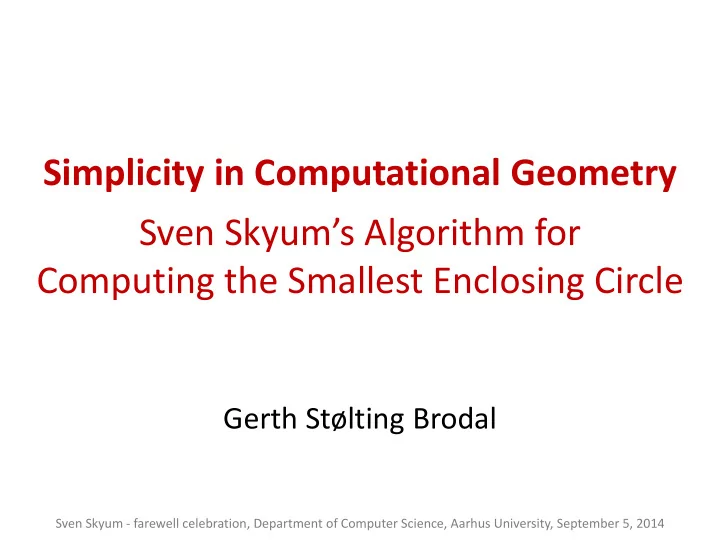

Simplicity in Computational Geometry Sven Skyum’s Algorithm for Computing the Smallest Enclosing Circle Gerth Stølting Brodal Sven Skyum - farewell celebration, Department of Computer Science, Aarhus University, September 5, 2014
Sven Skyum, A Simple Algorithm for Computing the Smallest Enclosing Circle . Information Processing Letters, Volume 37, Issue 3, 18 February 1991, Pages 121 – 125
Smallest Enclosing Circle
History Year Result Authors 1857 problem posed Sylvester 1860 ”graphical solution procedure” Pierce Just because a problem A can be 1965 Lawson quadratic formulated as a special case of B is no reason for believing that a programming Zhukhovitsky, general method for solving B 1966 𝑗 (𝑦 𝑗 − 𝑦 0 ) 2 +(𝑧 𝑗 − 𝑧 0 ) 2 is an efficient way of solving A 𝑞 0 ∈ℝ 2 max min Avdeyeva - Preparata & Shamos, 1985 O( n 4 ) ”The obvious” 1972 O( n 3 ), O( h 3 ∙ n ), O( n 2 ) Elzinga, Hearn 1975 O( n ∙ log n ) Shamos, Hoey 1977 O( n ∙ log n ) Preparata 1981 O( n ∙ h ) Chakraborty, Chaudhuri …the involved constants hidden in O(n) are large. 1983 O( n ) Megiddo - Skyum, 1991 However his method is not nearly as easy to 1991 O( n ∙ log n ) Skyum describe and to implement, and the dependence of the constant in d falls far behind the one 1991 O( n ), expected Welzl achieved by our method. - Welzl, 1991
p 7 p 8 Smallest Enclosing Circle p 6 p 1 p 5 convex hull – O( n ∙log n ) time p 4 p 2 p 3 Convex polygon S = ( p 1 , p 2 , p 3 , … , p n )
Observations C 2 p 5 C 6 > 90 ⁰ C 1 p 4 C 3 > 90 ⁰ p 6 p 3 p 2 C 5 p 1 < 90⁰ C 4 Rademacher, Toeplitz 1957
Algorithm 1. if | S |≠1 then finish := false; repeat (1) find p in S maximizing (radius(before( p ), p , next( p )), angle(before( p ), p ,next( p )) in the lexicographic order; (2) if angle(before( p ), p , next( p )) ≤ π /2 then finish := true next( p ) else remove p from S p fi before( p ) until finish fi; { answer is SEC(before( p ), p , next( p )) }
Top 20 citing Skyum’s algorithm 1. Movement-assisted sensor deployment 2. Distributed control of robotic networks: a mathematical approach to motion coordination algorithms 3. Smallest enclosing disks (balls and ellipsoids) 4. Coordination and geometric optimization via distributed dynamical systems 5. Design Techniques and Analysis 6. Circle formation for oblivious anonymous mobile robots with no common sense of orientation 7. Reactive data structures for geographic information systems 8. Distributed circle formation for anonymous oblivious robots 9. Imaging knee position using MRI, RSA/CT and 3D digitisation 10. The organization of mature Rous sarcoma virus as studied by cryoelectron microscopy 11. Hyperbolic Voronoi diagrams made easy 12. Collaborative area monitoring using wireless sensor networks with stationary and mobile nodes 13. Approximating smallest enclosing balls with applications to machine learning 14. The deployment algorithms in wireless sensor net works: A survey 15. Adaptive and distributed coordination algorithms for mobile sensing networks 16. ISOGRID: An efficient algorithm for coverage enhancement in mobile sensor networks 17. A novel hybrid approach to ray tracing acceleration based on pre-processing & bounding volumes 18. Fast neighborhood search for the nesting problem 19. Local strategies for connecting stations by small robotic networks 20. Algorithmic problems on proximity and location under metric constraints
Thank You Sven
Recommend
More recommend